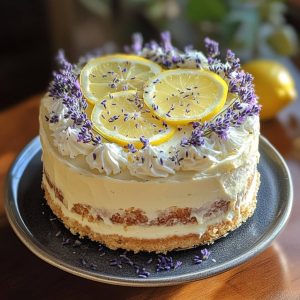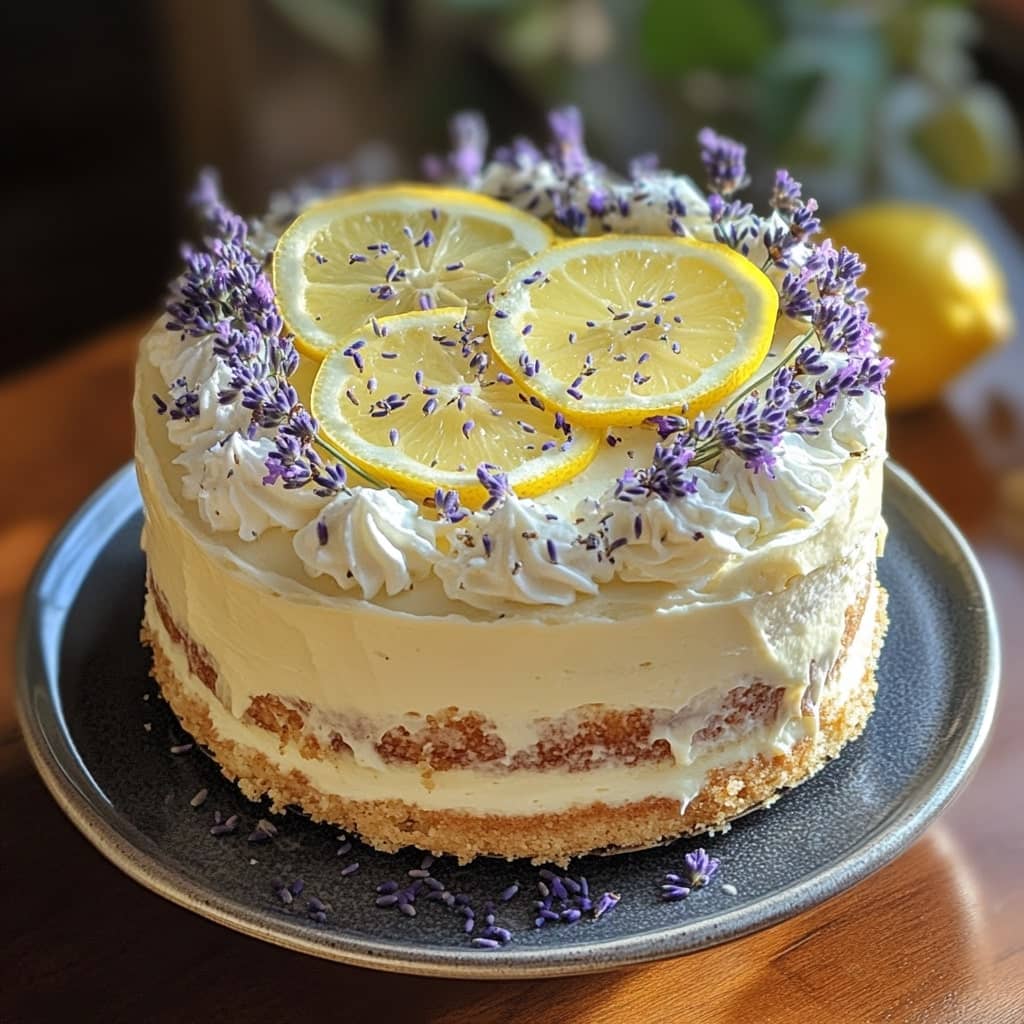Lemon Lavender Cake is a delightful and aromatic dessert that combines the bright, citrusy flavor of lemon with the subtle floral notes of culinary lavender. This cake is known for its elegant and refreshing taste, making it a popular choice for spring and summer gatherings, bridal showers, garden parties, or simply as a treat for those who appreciate unique flavor combinations. With roots in traditional European baking, particularly in French and British cuisine, the use of lavender in desserts has been growing in popularity thanks to its gentle fragrance and natural pairing with lemon. The combination brings a touch of sophistication and a rustic, countryside charm to a classic tea-time treat.
The origins of lemon cake can be traced back to centuries-old recipes that utilized lemon zest and juice to enhance basic sponge or butter cakes. Lemon desserts gained prominence during the Victorian era, especially in England, where lemon drizzle cake became a tea-time staple. Lavender, on the other hand, has long been used in culinary practices in the Mediterranean and Provence regions of France. The practice of combining lemon and lavender in baked goods is relatively modern but draws upon these historical traditions. The pairing not only complements the flavors but also provides therapeutic aromas, making it as pleasant to smell as it is to taste.
Ingredients Breakdown
1 ½ cups all-purpose flour (provides structure and base for the cake)
1 tsp baking powder (helps the cake rise)
½ tsp baking soda (works with the acid in lemon to leaven)
¼ tsp salt (enhances flavor and balances sweetness)
2 tbsp dried culinary lavender buds (adds floral aroma and unique taste; culinary grade only)
¾ cup granulated sugar (sweetens and helps with cake texture)
½ cup unsalted butter, softened (adds richness and moisture)
2 large eggs (binds ingredients and contributes to texture)
⅓ cup sour cream or Greek yogurt (adds moisture and a slight tang)
2 tbsp fresh lemon juice (provides citrusy flavor)
1 tbsp lemon zest (intensifies the lemon aroma)
½ tsp vanilla extract (adds depth of flavor)
½ cup milk (adjusts consistency and contributes to softness)
For the glaze (optional but recommended):
1 cup powdered sugar
1–2 tbsp lemon juice
1 tsp dried lavender (optional, for garnish)
Step-by-Step Recipe
Preheat your oven to 350°F (175°C) and grease a 9-inch round or loaf cake pan with butter or line with parchment paper. In a mixing bowl, whisk together the flour, baking powder, baking soda, and salt. Crush the lavender buds slightly using a mortar and pestle or the back of a spoon to release their oils, then mix into the dry ingredients. In a separate large bowl, cream together the butter and granulated sugar until light and fluffy, about 3–4 minutes. Add in the eggs, one at a time, beating well after each addition. Stir in the sour cream (or Greek yogurt), lemon juice, lemon zest, and vanilla extract. Gradually add the dry ingredients to the wet ingredients, alternating with the milk, beginning and ending with the flour mixture. Mix until just combined—do not overmix. Pour the batter into the prepared pan and smooth the top. Bake for 35–45 minutes, or until a toothpick inserted in the center comes out clean. Let the cake cool in the pan for 10 minutes before transferring to a wire rack to cool completely. For the glaze, whisk the powdered sugar with lemon juice until smooth. Drizzle over the cooled cake and garnish with a few lavender buds if desired.
Tips for the Perfect Lemon Lavender Cake
Use only culinary-grade lavender; other types may be too pungent or not food-safe. Slightly crushing the lavender before mixing helps release the essential oils, enhancing the flavor. Do not overmix the batter, as this can lead to a dense texture. Room-temperature ingredients (butter, eggs, milk) help with even mixing and better texture. If your lemons are unwaxed and organic, make the most of them by zesting before juicing. Adjust lavender quantity to taste—some people prefer a more subtle hint. Always sift powdered sugar for the glaze to ensure it’s lump-free and smooth. For a moist cake, avoid overbaking—check doneness at the 35-minute mark. Letting the cake rest overnight enhances the lavender flavor as the oils permeate the cake. Pair with whipped cream, lemon curd, or berries for a complete dessert experience.
Variations and Customizations
Substitute almond or oat flour for a gluten-free version, adjusting liquids as needed. Replace butter with coconut oil and dairy with plant-based alternatives for a vegan adaptation. For a stronger lavender presence, infuse milk with lavender by gently heating and steeping it before use. Add blueberries to the batter for a fruity twist and complementary flavor. Incorporate a layer of lemon curd in the middle of the cake for extra zing. Use a bundt pan for an elegant presentation, adjusting bake time as necessary. Top with candied lemon slices or edible flowers for decoration. Mix in a touch of honey for natural sweetness and added depth. Make cupcakes instead of a full cake for portion control or party servings. Create a two-layer cake with lavender buttercream for special occasions.
Health Considerations and Nutritional Value
Lemon Lavender Cake, while a treat, can be adjusted to be more health-conscious. Lemon provides a good dose of vitamin C and antioxidants, while lavender is believed to have calming effects, potentially aiding stress relief and digestion. Using Greek yogurt instead of sour cream adds protein and reduces fat. You can reduce the sugar content slightly without losing the integrity of the cake. Whole wheat flour can be substituted for some of the white flour for added fiber. If opting for plant-based ingredients, choose unsweetened and fortified milk alternatives for added nutrients. Be mindful that lavender can be potent; in large amounts, it may cause sensitivity in some individuals. This cake is relatively rich due to the butter and sugar content, so moderation is key. As a dessert, it’s best enjoyed occasionally, complemented with fresh fruit or tea to balance out its indulgence.
FAQ
Can I use fresh lavender instead of dried? Yes, but use about twice the amount and ensure it is pesticide-free and culinary safe.
How long does the cake stay fresh? It stays moist and flavorful for up to 3 days at room temperature in an airtight container or 5–6 days in the fridge.
Can I freeze Lemon Lavender Cake? Yes, wrap it tightly in plastic wrap and freeze for up to 3 months; glaze only after thawing.
Is it safe for kids? Yes, in small amounts—just ensure the lavender used is culinary-grade and not overly strong.
What can I substitute for lavender if I don’t like the taste? Try rosemary, thyme, or omit entirely and enhance the lemon instead.
Why is my cake dense? Overmixing or not creaming the butter and sugar properly can cause a dense texture.
Can I make this cake gluten-free? Yes, use a 1:1 gluten-free flour blend and consider adding a binding agent like xanthan gum.
What type of pan works best? A standard 9-inch round or loaf pan works well, but bundt or cupcake pans can be used for variations.

Lemon Lavender Cake
Ingredients
For the Lemon Lavender Cake Layers
- 3 cups 360g all-purpose flour
- 2 1/2 teaspoons baking powder
- 1/2 teaspoon baking soda
- 1/2 teaspoon kosher salt
- 2 cups 400g granulated sugar
- 2 tablespoons finely grated lemon zest from approximately 4 lemons
- 1 tablespoon dried culinary lavender
- 1/2 cup 113g unsalted butter, at room temperature
- 1/2 cup 120ml vegetable oil
- 4 large eggs at room temperature
- 1 teaspoon vanilla extract
- 1/3 cup 80ml freshly squeezed lemon juice
- 1 cup 240ml whole milk
For the Lemon Buttercream Frosting
- 1 1/2 cups 3 sticks unsalted butter, at room temperature
- 6 cups 680g powdered sugar
- 1/3 cup 80ml whole milk
- 1 tablespoon lemon extract
Instructions
Method
- Preheat the Oven
- Set your oven to 350°F (175°C).
Prepare the Cake Pans
- Grease two 8-inch round cake pans with butter. Line each with parchment paper, then grease the parchment. Dust the bottom and sides with flour, tapping out any excess.
Mix the Dry Ingredients
- In a medium bowl, whisk together the flour, baking powder, baking soda, and salt. Set aside.
Infuse the Sugar
- In a food processor, combine the sugar, lemon zest, and dried lavender. Process for 1 to 3 minutes, until the lavender is finely ground and both the zest and lavender are evenly distributed throughout the sugar.
Cream Butter, Oil, and Sugar
- In the bowl of a stand mixer fitted with the paddle attachment (or using a hand mixer), beat the butter, vegetable oil, and lemon-lavender sugar on medium-high speed for about 4 minutes, until the mixture is very pale, fluffy, and has nearly tripled in volume.
Add Eggs and Vanilla
- Beat in the eggs one at a time, making sure each is fully incorporated before adding the next. Scrape down the sides and bottom of the bowl as needed. Stir in the vanilla extract.
Combine Wet and Dry Ingredients
- Add half of the flour mixture to the creamed butter mixture and mix on low speed until just combined. Pour in the milk and lemon juice, mixing again on low speed. Add the remaining flour mixture and mix until just incorporated — it’s okay if there are a few small lumps. Use a rubber spatula to scrape the bowl in between to ensure even mixing.
Bake the Cakes
- Divide the batter evenly between the two prepared pans. Bake for 30 to 35 minutes, or until a toothpick inserted into the center comes out clean. The edges should begin to pull away from the pans, and the center should spring back when gently pressed.
Cool the Cake Layers
- Let the cakes cool in the pans for 15 minutes. Then, turn them out onto a wire rack and allow them to cool completely before frosting.
Frosting & Assembly
- Prepare the Frosting – Beat the Butter
- In a stand mixer with the paddle attachment (or using a hand mixer), beat the butter on medium speed for about 2 minutes, until smooth and satiny.
- Add Powdered Sugar, Milk, and Lemon Extract
- Add the powdered sugar, half of the milk, and the lemon extract. Beat on medium speed until the mixture becomes light and fluffy, about 2 minutes. If needed, add more milk 1 tablespoon at a time to reach your desired frosting consistency.
Assemble the Cake
- Place one cake layer right-side-up on a plate or 10-inch cake board. Spread 1/2 to 1 cup of frosting evenly on top. Place the second cake layer upside-down on top to create a flat, smooth surface. Make sure the layers are centered and level.
Apply the Crumb Coat
- Using an offset spatula or butter knife, spread a thin, even layer of frosting over the top and sides of the cake. This crumb coat traps any loose crumbs and helps create a clean finish for the final layer.
Chill the Cake
- Refrigerate the crumb-coated cake for 20 minutes to let the frosting set. Cover the bowl of frosting in the meantime.
Frost the Cake
- Once chilled, remove the cake from the fridge. Stir the frosting to smooth it out again. Apply a generous layer over the top and sides of the cake, smoothing it out with a spatula, spoon, or butter knife.
Storage Tips
- Store the finished cake in a cake saver on the counter for up to 4 days.
- For leftover slices, cover them with plastic wrap on a plate.
- If part of the cake has been cut, cover the exposed edges with plastic wrap or parchment paper to prevent them from drying out.

